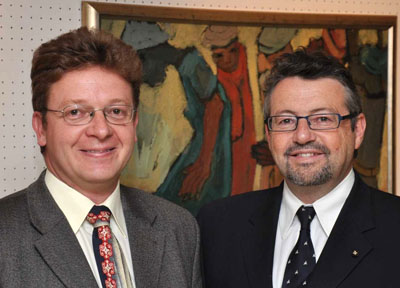Prof. Iain Benson delivers inaugural lecture in UFS's Faculty of Law
 |
| Prof. Shaun de Freitas (left) of the Faculty of Law at the UFS and Prof. Iain Benson. |
Prof. Iain T. Benson delivered his inaugural address as Professor Extraordinary in the Department of Constitutional Law and Philosophy of Law in the Faculty of Law at University of the Free State (UFS) faculty last week.
Originally hailing from Canada and currently residing with his family in France, Prof. Benson is an academic with a wealth of experience and expertise in the field of law, especially with regard to the right of conscience and religion. His achievements number many, including being a Senior Associate Counsel at one of Canada’s leading law firms, Miller Thompson LLP; and serving on the Founding Board of the Global Centre for Pluralism.
Apart from his work on leading cases in the United Kingdom and Ireland, Prof. Benson also has strong ties with the law in South Africa. He is part of the Continuity Committee that is responsible for the major undertaking of drawing up the South African Charter of Religious Rights and Freedoms in cooperation with all the major religions in South Africa which, when completed, will be the first use of Section 234 of the South African Constitution.
The title of the inaugural lecture was Living together with Disagreements and the Limits of the Law, which tackled various conscientious and topical issues regarding the complex relationships between the law and religions. Starting off the lecture, Prof. Benson recalled that living together with disagreement is a necessary achievement in free and democratic societies and that differences of belief and opinion should not be resolved by force acceptance of a “one-size fits all” model. Mentioning religion and same-sex marriages, Prof. Benson held these up as issues which reasonable people may disagree on and should hence be respected by the public sphere that is girded round by the law.
Quoting Sophocles’ Antigone, Prof. Benson noted that tensions between the so-called divine and imminent or state laws as in a non-theocratic state have always been with us. He stressed the importance of a wide respect by the law for civic associations in addition to but particularly in relation to religion which guides citizens views about wrong and right beyond matters that are regulated by law.